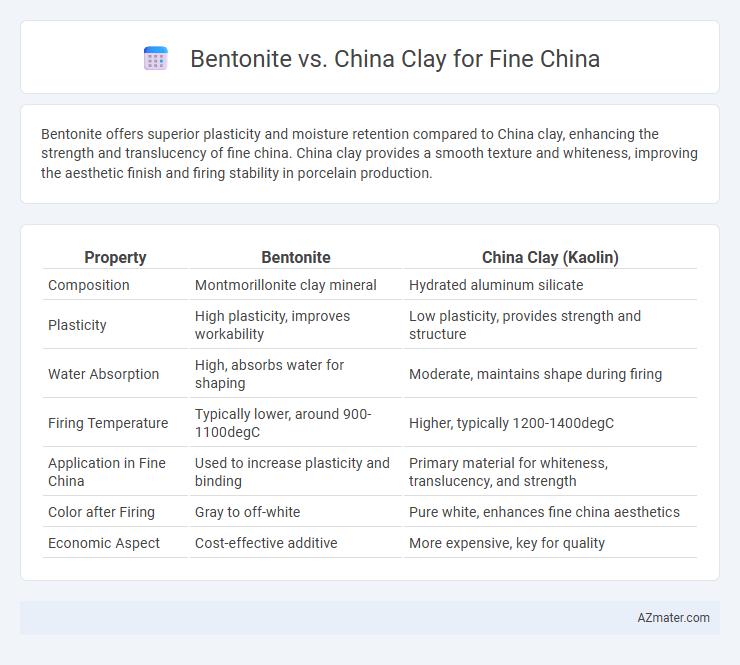Bentonite offers superior plasticity and moisture retention compared to China clay, enhancing the strength and translucency of fine china. China clay provides a smooth texture and whiteness, improving the aesthetic finish and firing stability in porcelain production.
Table of Comparison
| Property | Bentonite | China Clay (Kaolin) |
|---|---|---|
| Composition | Montmorillonite clay mineral | Hydrated aluminum silicate |
| Plasticity | High plasticity, improves workability | Low plasticity, provides strength and structure |
| Water Absorption | High, absorbs water for shaping | Moderate, maintains shape during firing |
| Firing Temperature | Typically lower, around 900-1100degC | Higher, typically 1200-1400degC |
| Application in Fine China | Used to increase plasticity and binding | Primary material for whiteness, translucency, and strength |
| Color after Firing | Gray to off-white | Pure white, enhances fine china aesthetics |
| Economic Aspect | Cost-effective additive | More expensive, key for quality |
Introduction to Fine China Materials
Fine china primarily utilizes kaolin, commonly known as China clay, due to its pure white color and plasticity, which provides a smooth texture and translucency essential for delicate dinnerware. Bentonite, a smectite clay, is occasionally added to enhance plasticity and improve the shaping process but is less favored for its color and firing properties. The balance between China clay's purity and Bentonite's plasticity determines the porcelain's strength, translucency, and overall quality.
Overview of Bentonite and China Clay
Bentonite is a highly absorbent, swelling clay primarily composed of montmorillonite, renowned for its strong plasticity and excellent binding properties in fine china production. China clay, also known as kaolin, consists mainly of kaolinite, offering a smooth texture and high whiteness that enhances the translucency and brightness of fine china ceramics. Both materials serve critical roles: bentonite improves green strength and workability, while china clay provides whiteness, plasticity, and resistance to high firing temperatures.
Chemical Composition Comparison
Bentonite primarily consists of montmorillonite, a smectite group clay mineral characterized by a high content of silica (SiO2), alumina (Al2O3), and water, with notable quantities of magnesium and calcium ions contributing to its swelling properties. China clay, or kaolin, is mainly composed of kaolinite, a hydrous aluminum silicate with a chemical formula close to Al2O3*2SiO2*2H2O, exhibiting lower silica content and higher alumina content compared to bentonite. The distinct chemical compositions influence their plasticity, firing behavior, and whiteness levels, making bentonite ideal for enhancing plasticity and China clay for providing whiteness and strength in fine china production.
Physical Properties of Bentonite vs China Clay
Bentonite exhibits superior swelling capacity and plasticity compared to China clay, making it highly effective in enhancing the malleability of fine china. China clay, characterized by its fine particle size and high brightness, provides excellent whiteness and smooth texture essential for the aesthetic quality of fine china. The higher cation exchange capacity and water absorption of Bentonite contribute to improved rheological properties, whereas China clay offers better mechanical strength and thermal stability in ceramic applications.
Role in Fine China Production
Bentonite acts as a crucial binder and plasticizer in fine china production, enhancing the workability and strength of the clay body while improving its firing properties. China clay, or kaolin, provides the essential whiteness and translucency that defines fine china, contributing to its characteristic smooth texture and durability. The combination of bentonite's plasticity and china clay's purity ensures optimal shaping and finishing qualities in high-quality fine china products.
Effects on Strength and Durability
Bentonite enhances the strength and durability of fine china by improving plasticity and particle binding, which results in fewer cracks and increased resistance to thermal shock. China clay, primarily kaolin, contributes to the vitrification process, enhancing whiteness and surface smoothness but offering less reinforcement to mechanical strength compared to bentonite. Combining bentonite and china clay optimizes the balance between structural integrity and aesthetic quality in fine china production.
Impact on Color and Texture
Bentonite enhances the translucency and whiteness in fine china by contributing to a smoother, more plastic texture, which improves the clay's workability and firing strength. China clay (kaolin) imparts a bright white color and a fine, smooth texture, essential for achieving the delicate finish and high-fired durability characteristic of fine porcelain. The combination of bentonite and china clay balances plasticity and whiteness, optimizing the color purity and tactile quality of fine china products.
Cost and Availability Analysis
Bentonite offers a cost-effective alternative to China clay due to its abundant availability and lower extraction expenses, making it a preferred choice in the fine china manufacturing industry. China clay, while providing superior whiteness and plasticity, often incurs higher costs linked to limited regional deposits and intensive processing requirements. Manufacturers must balance the trade-offs between bentonite's affordability and China clay's quality attributes to optimize production budgets and product performance.
Environmental Considerations
Bentonite offers superior swelling and binding properties, reducing the need for synthetic additives, which lowers environmental impact during fine china production. China clay, while abundant and easy to process, often requires higher energy for purification and can generate more mining waste, posing greater ecological challenges. Choosing bentonite over china clay supports sustainable manufacturing due to its natural plasticity and ability to improve moldability with minimal processing.
Conclusion: Choosing the Best Material for Fine China
Bentonite offers superior plasticity and excellent particle binding properties, making it ideal for creating fine china with enhanced durability and a smooth finish. China clay, known for its whiteness and purity, provides a delicate texture and translucency favored in high-quality fine china production. Selecting bentonite or china clay depends on the desired balance between strength and aesthetic refinement in the final fine china product.

Infographic: Bentonite vs China clay for Fine china
 azmater.com
azmater.com